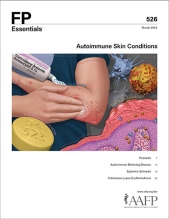
This clinical content conforms to AAFP criteria for CME.
Systemic sclerosis (formerly scleroderma) is a relatively rare autoimmune connective tissue disease which symmetrically affects the skin and affects the internal organs. There are two types: limited cutaneous and diffuse cutaneous. Each type is categorized by different clinical, systemic, and serologic findings. Autoantibodies can be used to predict phenotype and internal organ involvement. Systemic sclerosis can affect the lungs, gastrointestinal system, kidneys, and heart. Pulmonary and cardiac disease are the leading causes of death, so screening for these conditions is important. Early management of systemic sclerosis is paramount to prevent progression. Numerous therapeutic interventions for systemic sclerosis exist, but there is no cure. The goal of therapy is to improve quality of life by minimizing specific organ-threatening involvement and life-threatening disease.
Case 3. KF is a 43-year-old patient who comes to your office reporting fatigue and puffy hands. She reports that for years when she goes outside in the fall and winter, her fingers change color and become quite painful. Lately her fingers have gotten thicker, and her wedding ring no longer fits. The antinuclear antibody (ANA) titer has been elevated in the past. On examination, you note bilateral thickening of the skin of her fingers all the way up to her wrists.
Systemic sclerosis comprises two major clinical subtypes: limited cutaneous (lcSSc) and diffuse cutaneous (dcSSc). lcSSc comprises approximately two-thirds of cases, and dcSSc comprises one-third.106 Systemic sclerosis affects the skin in a symmetric pattern, as opposed to some of its clinical mimics. lcSSc affects the fingers, hands, and face and is characterized by sclerotic skin changes. lcSSc is more common in women and has a milder disease course than dcSSc. lcSSc was formerly labeled CREST syndrome, which is an acronym outlining its clinical findings: calcinosis cutis, Raynaud phenomenon, esophageal dysmotility, sclerodactyly, and telangiectasia (although not every patient has all five features). dcSSc is generalized and begins in the fingers and hands (Figure 4) and eventually extends to the forearms, arms, face, trunk, and lower extremities. Another condition called morphea (which has sometimes been called localized scleroderma), clinically presents as focal hardening of the skin but has no systemic manifestations. Morphea is outside of the scope of this FP Essentials.
Subscribe
From $350- Immediate, unlimited access to FP Essentials content
- 60 CME credits/year
- AAFP app access
- Print delivery available
Edition Access
$44- Immediate, unlimited access to this edition's content
- 5 CME credits
- AAFP app access
- Print delivery available
